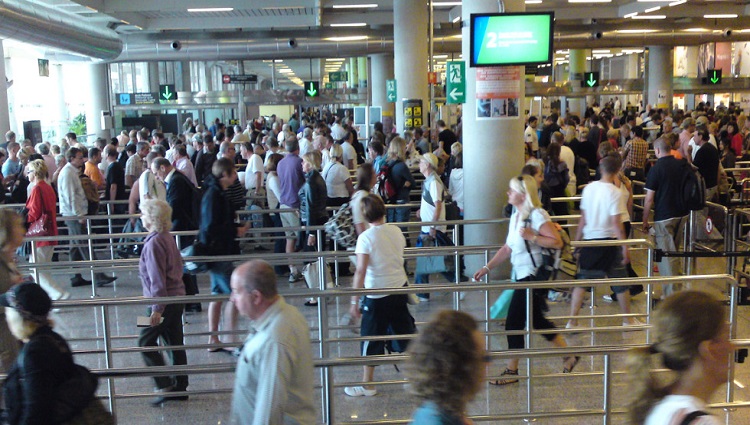For Some Diseases, Quarantines Could Be Counterproductive
(Inside Science) -- A virulent infection hopping from person to person in an airport or a violent idea championed in an online chatroom can both spread contagiously, ultimately endangering lives. Now scientists counter-intuitively find that the best way to counteract this spread through popular sites may sometimes be to increase the flow of traffic, not reduce it. Unexpectedly, these findings might also help improve advanced electronics that depend on atomic spin.
Physicists Pedro Manrique and Neil Johnson at the University of Miami had long wondered how the volume of traffic affected the spread of diseases such as Zika, which Florida officials confirmed had a foothold in Miami-Dade County in July.
"As a parent of kids in the school system, I also wondered what the best procedure should be when cases of an outbreak occur," Johnson said. "Is it best to close the schools completely for a few days, or have less rotation of students through classes -- that is, keep them in the same group all day -- or what?"
Research into the spread of contagions not only applies to diseases but also to rumors, propaganda and extreme views. "There are people who visit frequently particular chatrooms and also people who spend a long time in one," Johnson said. "What is the interplay between these two on the contagion of extremist ideas?"
Manrique, Johnson and their colleagues focused on viral spreading in popular places "such as airports, Starbucks cafes, cruise ship ports, schools, hospitals, and so on," Johnson said. "They can also be online."
Previous research typically assumed that viral spreading would increase with higher traffic. As such, the only way to deal with viral spreading through popular sites previously "was to shut everything down," Johnson said.
The scientists found that the best strategy for preventing the spread of contagions through high traffic places depended on the rate at which the contagion is transmitted from an infected person to a neighboring uninfected person. When the rate of infection was high, such as with the flu, it was best as previously thought to reduce the flow of people through such places. This also holds true for places infested with infectious mosquitoes and other carriers of disease.
However, when the rate of infection was low, such as with sexually transmitted diseases, the best strategy was to increase the flow of people entering and leaving popular places so that people on average spend less time there. This is because the less time people spend in a popular place, the less likely they are to get such infections.
"This strategy is very different from -- in fact the opposite to -- the standard approach of quarantine," Johnson said. "There is no one-size-fits-all strategy, like 'close or open the popular place.' It depends on the details of the infection and its spreading."
The researchers' new model delivered predictions that agreed with real-world data of recent contagions, such as rumors regarding Chinese currency and the spread of civil unrest during the Arab Spring and in Latin America.
The scientists have now started applying their findings to Zika in Florida, especially given that "schools will be opening soon, and airports will become busy," Johnson said. "It would be straightforward for us to take the flow of traffic and people between different regions of Miami-Dade and Broward [counties]." Zika spreads both through places infested with mosquitoes and through sexual transmission, so Johnson suggests that both the strategies they outlined may apply to Zika depending on the location.
In addition, the researchers are now examining if they could provide schools with recommendations about when to close. They are also reviewing the schedules of flights through Miami International Airport, "putting in typical numbers of flight occupancy and hence calculating the mobility through, and occupancy of, Miami International Airport as a function of time throughout the year," Johnson said. "This will help us give a precise plan of action for something like Zika and beyond."
Furthermore, "we are also looking at numbers of visitors, and frequency of visits, to pro-ISIS websites to see how quickly ideas and propaganda spread and what might be done about it to reduce the infection spread," Johnson said. "Should focus be spent on monitoring and perhaps limiting the number of extreme sites being accessed by individuals, or the time spent in each?"
"Huge opportunities now exist to test and develop this model further, using a variety of real world data sources," said computational social scientist Tobias Preis at the University of Warwick in England, who did not take part in this research. "For example, we now know much more about how people move around on both local and global scales, thanks to data from mobile phones and other digital traces we leave behind. "
Surprisingly, the scientists also found their results might apply to spintronics, which aims to build tinier and more powerful electronics by manipulating atomic spin. A key challenge in spintronics is generating pulses of particles that are spin-polarized, or all have the same spin. "If you try to polarize an electron, the analogy of making it 'infected,' it will gradually become depolarized — that is, 'recovered' from the infection," Johnson said. Their model could shed light on how to keep particles polarized when contained together.
The scientists detailed their findings in a paper that was accepted July 26 by the journal Physical Review E.


